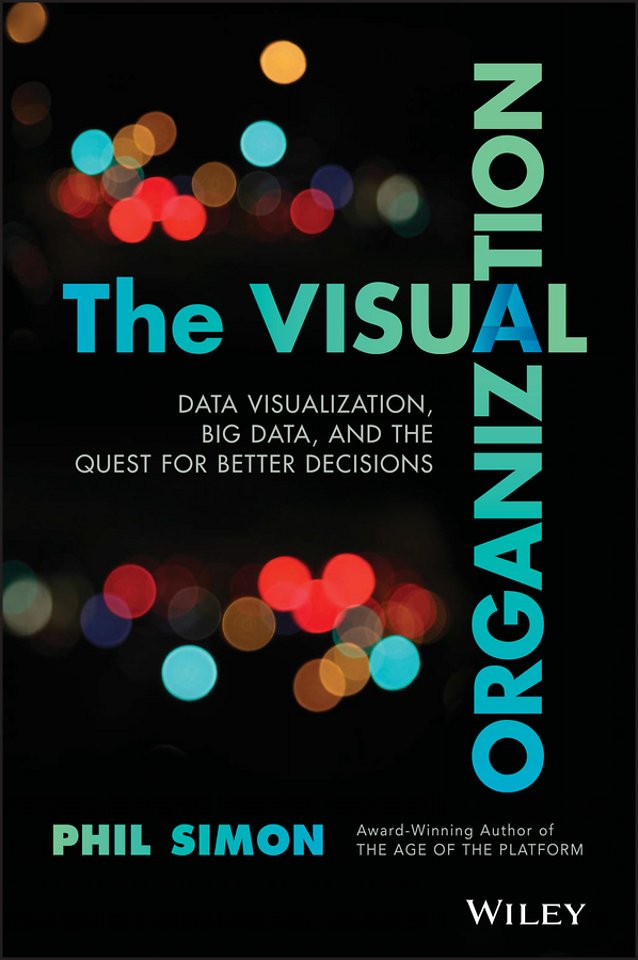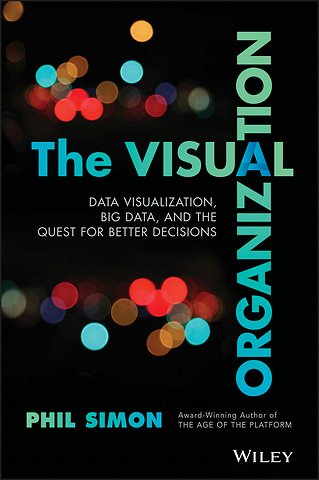The Visual Organization – Data Visualization, Big Data, and the Quest for Better Decisions
Data Visualization, Big Data, and the Quest for Better Decisions
Gebonden Engels 2014 9781118794388Samenvatting
The era of Big Data as arrived, and most organizations are woefully unprepared. Slowly, many are discovering that stalwarts like Excel spreadsheets, KPIs, standard reports, and even traditional business intelligence tools aren′t sufficient. These old standbys can′t begin to handle today′s increasing streams, volumes, and types of data.
Amidst all of the chaos, though, a new type of organization is emerging.
In The Visual Organization, award–winning author and technology expert Phil Simon looks at how an increasingly number of organizations are embracing new dataviz tools and, more important, a new mind–set based upon data discovery and exploration. Simon adroitly shows how Amazon, Apple, Facebook, Google, Twitter, and other tech heavyweights use powerful data visualization tools to garner fascinating insights into their businesses. But make no mistake: these companies are hardly alone. Organizations of all types, industries, sizes are representing their data in new and amazing ways. As a result, they are asking better questions and making better business decisions.
Rife with real–world examples and case studies, The Visual Organization is a full–color tour–de–force.
Specificaties
Lezersrecensies
Inhoudsopgave
<p>Preface xix</p>
<p>Acknowledgments xxv</p>
<p>How to Help This Book xxvii</p>
<p>Part I Book Overview and Background 1</p>
<p>Introduction 3</p>
<p>Adventures in Twitter Data Discovery 4</p>
<p>Contemporary Dataviz 101 9</p>
<p>Primary Objective 9</p>
<p>Benefits 11</p>
<p>More Important Than Ever 13</p>
<p>Revenge of the Laggards: The Current State of Dataviz 15</p>
<p>Book Overview 18</p>
<p>Defining the Visual Organization 19</p>
<p>Central Thesis of Book 19</p>
<p>Cui Bono? 20</p>
<p>Methodology: Story Matters Here 21</p>
<p>The Quest for Knowledge and Case Studies 24</p>
<p>Differentiation: A Note on Other Dataviz Texts 25</p>
<p>Plan of Attack 26</p>
<p>Next 27</p>
<p>Notes 27</p>
<p>Chapter 1 The Ascent of the Visual Organization 29</p>
<p>The Rise of Big Data 30</p>
<p>Open Data 30</p>
<p>The Burgeoning Data Ecosystem 33</p>
<p>The New Web: Visual, Semantic, and API–Driven 34</p>
<p>The Arrival of the Visual Web 34</p>
<p>Linked Data and a More Semantic Web 35</p>
<p>The Relative Ease of Accessing Data 36</p>
<p>Greater Efficiency via Clouds and Data Centers 37</p>
<p>Better Data Tools 38</p>
<p>Greater Organizational Transparency 40</p>
<p>The Copycat Economy: Monkey See, Monkey Do 41</p>
<p>Data Journalism and the Nate Silver Effect 41</p>
<p>Digital Man 44</p>
<p>The Arrival of the Visual Citizen 44</p>
<p>Mobility 47</p>
<p>The Visual Employee: A More Tech– and Data–Savvy Workforce 47</p>
<p>Navigating Our Data–Driven World 48</p>
<p>Next 49</p>
<p>Notes 49</p>
<p>Chapter 2 Transforming Data into Insights: The Tools 51</p>
<p>Dataviz: Part of an Intelligent and Holistic Strategy 52</p>
<p>The Tyranny of Terminology: Dataviz, BI, Reporting, Analytics, and KPIs 53</p>
<p>Do Visual Organizations Eschew All Tried–and–True Reporting Tools? 55</p>
<p>Drawing Some Distinctions 56</p>
<p>The Dataviz Fab Five 57</p>
<p>Applications from Large Enterprise Software Vendors 57</p>
<p>LESVs: The Case For 58</p>
<p>LESVs: The Case Against 59</p>
<p>Best–of–Breed Applications 61</p>
<p>Cost 62</p>
<p>Ease of Use and Employee Training 62</p>
<p>Integration and the Big Data World 63</p>
<p>Popular Open–Source Tools 64</p>
<p>D3.js 64</p>
<p>R 65</p>
<p>Others 66</p>
<p>Design Firms 66</p>
<p>Startups, Web Services, and Additional Resources 70</p>
<p>The Final Word: One Size Doesn t Fit All 72</p>
<p>Next 73</p>
<p>Notes 73</p>
<p>Part II Introducing the Visual Organization 75</p>
<p>Chapter 3 The Quintessential Visual Organization 77</p>
<p>Netflix 1.0: Upsetting the Applecart 77</p>
<p>Netflix 2.0: Self–Cannibalization 78</p>
<p>Dataviz: Part of a Holistic Big Data Strategy 80</p>
<p>Dataviz: Imbued in the Netflix Culture 81</p>
<p>Customer Insights 82</p>
<p>Better Technical and Network Diagnostics 84</p>
<p>Embracing the Community 88</p>
<p>Lessons 89</p>
<p>Next 90</p>
<p>Notes 90</p>
<p>Chapter 4 Dataviz in the DNA 93</p>
<p>The Beginnings 94</p>
<p>UX Is Paramount 95</p>
<p>The Plumbing 97</p>
<p>Embracing Free and Open–Source Tools 98</p>
<p>Extensive Use of APIs 101</p>
<p>Lessons 101</p>
<p>Next 102</p>
<p>Note 102</p>
<p>Chapter 5 Transparency in Texas 103</p>
<p>Background 104</p>
<p>Early Dataviz Efforts 105</p>
<p>Embracing Traditional BI 106</p>
<p>Data Discovery 107</p>
<p>Better Visibility into Student Life 108</p>
<p>Expansion: Spreading Dataviz Throughout the System 110</p>
<p>Results 111</p>
<p>Lessons 113</p>
<p>Next 113</p>
<p>Notes 114</p>
<p>Part III Getting Started: Becoming a Visual Organization 115</p>
<p>Chapter 6 The Four–Level Visual Organization Framework 117</p>
<p>Big Disclaimers 118</p>
<p>A Simple Model 119</p>
<p>Limits and Clarifications 120</p>
<p>Progression 122</p>
<p>Is Progression Always Linear? 123</p>
<p>Can a Small Organization Best Position Itself to Reach Levels 3 and 4? If So, How? 123</p>
<p>Can an Organization Start at Level 3 or 4 and Build from the Top Down? 123</p>
<p>Is Intralevel Progression Possible? 123</p>
<p>Are Intralevel and Interlevel Progression Inevitable? 123</p>
<p>Can Different Parts of the Organization Exist on Different Levels? 124</p>
<p>Should an Organization Struggling with Levels 1 and 2 Attempt to Move to Level 3 or 4? 124</p>
<p>Regression: Reversion to Lower Levels 124</p>
<p>Complements, Not Substitutes 125</p>
<p>Accumulated Advantage 125</p>
<p>The Limits of Lower Levels 125</p>
<p>Relativity and Sublevels 125</p>
<p>Should Every Organization Aspire to Level 4? 126</p>
<p>Next 126</p>
<p>Chapter 7 WWVOD? 127</p>
<p>Visualizing the Impact of a Reorg 128</p>
<p>Visualizing Employee Movement 129</p>
<p>Starting Down the Dataviz Path 129</p>
<p>Results and Lessons 133</p>
<p>Future 135</p>
<p>A Marketing Example 136</p>
<p>Next 137</p>
<p>Notes 137</p>
<p>Chapter 8 Building the Visual Organization 139</p>
<p>Data Tips and Best Practices 139</p>
<p>Data: The Primordial Soup 139</p>
<p>Walk Before You Run . . . At Least for Now 140</p>
<p>A Dataviz Is Often Just the Starting Point 140</p>
<p>Visualize Both Small and Big Data 141</p>
<p>Don t Forget the Metadata 141</p>
<p>Look Outside of the Enterprise 143</p>
<p>The Beginnings: All Data Is Not Required 143</p>
<p>Visualize Good and Bad Data 144</p>
<p>Enable Drill–Down 144</p>
<p>Design Tips and Best Practices 148</p>
<p>Begin with the End in Mind (Sort of) 148</p>
<p>Subtract When Possible 150</p>
<p>UX: Participation and Experimentation Are Paramount 150</p>
<p>Encourage Interactivity 151</p>
<p>Use Motion and Animation Carefully 151</p>
<p>Use Relative Not Absolute Figures 151</p>
<p>Technology Tips and Best Practices 152</p>
<p>Where Possible, Consider Using APIs 152</p>
<p>Embrace New Tools 152</p>
<p>Know the Limitations of Dataviz Tools 153</p>
<p>Be Open 153</p>
<p>Management Tips and Best Practices 154</p>
<p>Encourage Self–Service, Exploration, and Data Democracy 154</p>
<p>Exhibit a Healthy Skepticism 154</p>
<p>Trust the Process, Not the Result 155</p>
<p>Avoid the Perils of Silos and Specialization 156</p>
<p>If Possible, Visualize 156</p>
<p>Seek Hybrids When Hiring 157</p>
<p>Think Direction First, Precision Later 157</p>
<p>Next 158</p>
<p>Notes 158</p>
<p>Chapter 9 The Inhibitors: Mistakes, Myths, and Challenges 159</p>
<p>Mistakes 160</p>
<p>Falling into the Traditional ROI Trap 160</p>
<p>Always and Blindly Trusting a Dataviz 161</p>
<p>Ignoring the Audience 162</p>
<p>Developing in a Cathedral 162</p>
<p>Set It and Forget It 162</p>
<p>Bad Dataviz 163</p>
<p>TMI 163</p>
<p>Using Tiny Graphics 163</p>
<p>Myths 165</p>
<p>Data–visualizations Guarantee Certainty and Success 165</p>
<p>Data Visualization Is Easy 165</p>
<p>Data Visualizations Are Projects 166</p>
<p>There Is One Right Visualization 166</p>
<p>Excel Is Sufficient 167</p>
<p>Challenges 167</p>
<p>The Quarterly Visualization Mentality 167</p>
<p>Data Defiance 168</p>
<p>Unlearning History: Overcoming the Disappointments of Prior Tools 168</p>
<p>Next 169</p>
<p>Notes 169</p>
<p>Part IV Conclusion and the Future of Dataviz 171</p>
<p>Coda: We re Just Getting Started 173</p>
<p>Four Critical Data–Centric Trends 175</p>
<p>Wearable Technology and the Quantified Self 175</p>
<p>Machine Learning and the Internet of Things 176</p>
<p>Multidimensional Data 177</p>
<p>The Forthcoming Battle Over Data Portability and Ownership 179</p>
<p>Final Thoughts: Nothing Stops This Train 181</p>
<p>Notes 182</p>
<p>Afterword: My Life in Data 183</p>
<p>Appendix: Supplemental Dataviz Resources 187</p>
<p>Selected Bibliography 191</p>
<p>About the Author 193</p>
<p>Index 195</p>
Anderen die dit kochten, kochten ook
Rubrieken
- advisering
- algemeen management
- coaching en trainen
- communicatie en media
- economie
- financieel management
- inkoop en logistiek
- internet en social media
- it-management / ict
- juridisch
- leiderschap
- marketing
- mens en maatschappij
- non-profit
- ondernemen
- organisatiekunde
- personal finance
- personeelsmanagement
- persoonlijke effectiviteit
- projectmanagement
- psychologie
- reclame en verkoop
- strategisch management
- verandermanagement
- werk en loopbaan







